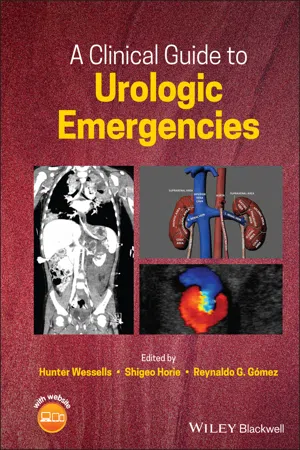
A Clinical Guide to Urologic Emergencies
- English
- ePUB (mobile friendly)
- Available on iOS & Android
A Clinical Guide to Urologic Emergencies
About this book
A Clinical Guide to Urologic Emergencies
An ageing population and a predicted shortfall in the number of urologists means that, increasingly, the management of complex urological problems will fall to hospital emergency departments and the surgeries of primary care physicians. With many doctors and medical students now having less exposure to urology, there is a real and urgent need for accessible and practical guidance in managing urologic emergencies.
A Clinical Guide to Urologic Emergencies offers practical guidance to the best practices in diagnosis, treatment and management of patients with urgent urological conditions. Designed to be an extremely useful tool to consult in the clinical setting, it will be a vital source of information and guidance for all clinicians, irrespective of their level of urologic knowledge.
Edited by an outstanding international editor team, this book is particularly aimed at physicians, advanced practice providers, and urology and emergency medicine trainees managing patients in diverse healthcare settings across the globe.
A Clinical Guide to Urologic Emergencies is accompanied by a website featuring video content at www.wiley.com/go/wessells/urologic
Frequently asked questions
- Essential is ideal for learners and professionals who enjoy exploring a wide range of subjects. Access the Essential Library with 800,000+ trusted titles and best-sellers across business, personal growth, and the humanities. Includes unlimited reading time and Standard Read Aloud voice.
- Complete: Perfect for advanced learners and researchers needing full, unrestricted access. Unlock 1.4M+ books across hundreds of subjects, including academic and specialized titles. The Complete Plan also includes advanced features like Premium Read Aloud and Research Assistant.
Please note we cannot support devices running on iOS 13 and Android 7 or earlier. Learn more about using the app.
Information
Section I
Upper Urinary Tract
1
Blunt Renal Injuries
Epidemiology, Etiology, Pathophysiology
Epidemiology and Etiology
| SERIES a | [6] | [14] | [15] | [1] b | [4] | [16] | [5] b | [17] | [18] | [19] |
|---|---|---|---|---|---|---|---|---|---|---|
| Year published | 1984 | 1986 | 1995 | 2001 | 2003 | 2012 | 2012 | 2013 | 2013 | 2014 |
| Renal injury (N) | 154 | 132 | 2254 | 227 | 6231 | 1505 | 221 | 338 | 9002 | 105 |
| Renal injury (%) | 2.9 | 3.25 | n/a | 1.4 | 1.2 | n/a | n/a | n/a | n/a | n/a |
| Blunt (%) | 93.5 | 95.4 | 89.8 | 93.4 | 81.6 | 95.0 | 100 | 96.2 | 82.0 | 96.1 |
| Penetrating (%) | 6.5 | 4.6 | 10.2 | 6.6 | 18.4 | 5.0 | 0 | 3.9 | 17.8 | 3.9 |
| Grade IV–V (%) | n/a | 14.6 | 10.9 | 29.3 | 21.1 | 23.5 | ||||
| Initial non‐operative management among all trauma (%) | 92.6 | 92.6 | n/a | 88.6 | 94.5 | n/a | 92.6 | 86.8 | 98.0 | |
| Initial non‐operative management among blunt trauma (%) | 98.3 | 89.5/92.9? | 96.3 | 92.3 | 92.6 | 94.4 | ||||
| Nephrectomy (%) among all trauma | 3.8 | 3.2 | 7.9 | 3.1 | n/a | 7.1 | 8.6 | 1.9 | ||
| Nephrectomy (%) among blunt trauma | 0 | 7.2 | 3.3 | 5.4 | 7.4 | 4.7 |
Pathophysiology
Table of contents
- Cover
- Table of Contents
- Title Page
- Copyright Page
- Dedication Page
- List of Contributors
- Preface
- List of Abbreviations
- About the Companion Website
- Section I: Upper Urinary Tract
- Section II: Lower Urinary Tract
- Section III: External Genitalia
- Section IV: Pediatric
- Section V: COVID‐19
- Index
- End User License Agreement